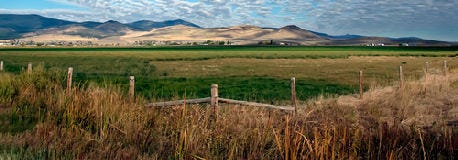May 16, 2013

By Dan Undersander
One of the most underutilized forage sources in the Midwest is pasture. It is often unmanaged generating less than half the forage it is capable of producing. Some of our measurements on unmanaged pasture have indicated an annual forage production of less than one ton per acre while managed pasture can easily yield four or more tons per acre. Increasing the forage from pasture can be a good way to meet forage needs when farms are short of forage.

A pasture can often be divided into three or four pie-shaped paddocks from the existing water source.
Most people think of reseeding when considering increasing pasture yield, but I would put this fourth on a list of return to investment (after weed control, fertilization and allotting/resting pastures during season). The exception would be to overseed areas that died during the drought last summer.
Weeds need not be controlled unless the thistle or brush is so thick that the grass will not grow or cattle will not graze. If so, an application of brush or broadleaf weed killer will kill or reduce the weed growth and let the grass come through. Check the herbicide label for proper time of application, rate and any restrictions on grazing after application.
Be sure to fertilize
The largest increase in pasture yield will be from fertilization. Grasses and clovers need nutrients to grow. The soil has limited ability to supply these and yield can be greatly increased by nutrient additions. The best is to soil test and fertilize according. (Be sure to specify that the crop to be grown is a grass or legume/grass pasture when submitting the soil sample; the analysis will be the same but fertilizer recommendations will be different than for alfalfa-corn-soybeans.)
Soil tests will indicate whether or not phosphorus and potassium are needed – some soils will be deficient and others not. Some or all of these nutrients may be supplied by manure.
All pastures will need nitrogen and sulfur for maximum yield. Consider that pasture forage contains 3% to 4% nitrogen. Thus every ton of forage from pastures requires 60 to 80 pounds of nitrogen. We should be planning for 2 tons per acre forage from the first spring growth (through mid-June). Thus, 120 to 160 pounds per acre nitrogen is needed. Slightly over half of this can come from soil residual, decomposing manure, etc. but 60 pounds per acre nitrogen fertilizer should be applied to maximize pasture forage yield. It can be applied any time after the pasture starts to green up and should show signs of yield enhancement within a week of application if rain has occurred to wash the nitrogen into the soil.
Set The Schedule For Hay Quality. Deciding when to make the first cutting of hay sets the stage for the rest of the year. Download our FREE report 10 Hay Farming Basics: Producing A Quality Hay Product today.
~~~PAGE_BREAK_HERE~~~
All pastures need sulfur since acid rain (which contained sulfur) has been greatly reduced. Each ton of pasture forage requires about 5 pounds per acre sulfur. The spring application of nitrogen can be ammonium sulfate (21-0-0-24S). This fertilizer should be applied in the spring as applications over summer, when temperature is high, will cause some grass firing. One can mix ammonium sulfate with urea to reduce the sulfur application (and cost). Sulfur can also be applied as gypsum (calcium sulfate, 0-0-0-19S) which is a neutral salt and has no effect on soil acidity but far less soluble than ammonium sulfate and hard to handle. A third choice for sulfur is potassium sulfate (0-0-50+18S) which can also supply potassium if this nutrient is also needed.
Limit access
The second biggest increase to forage production and utilization from pastures will be from allowing animals access to only a portion of the pasture at one time. When animal have access to the entire pasture, utilization is reduced because the animals trample much and they tend to graze and regraze the same spots. This means that some of the pasture matures, becoming low quality, less palatable and so unused, while the regrazed spots have reduced yield because they are kept short and not allowed to regrow.
A single roll of polywire with a few plastic or fiberglass posts and a battery-operated fence charger can increase pasture utilization from 30 to 40% up to 60 or 70%. A pasture can often be divided into three or four pie-shaped paddocks from the existing water source. Wire can be moved every four to seven days. This movement will increase forage utilization and keep cattle from regrazing new grass shoots, giving the pasture a time to recover and increase yield. While further gains can be made from more paddocks and increased management, three to four paddocks will proved the bulk of the benefit of rotational grazing.
Think of pasture as an underutilized resource and consider its value when hay is selling for $270 to $350 per ton!
Undersander is a University of Wisconsin Extension and research forage agronomist.
Set The Schedule For Hay Quality. Deciding when to make the first cutting of hay sets the stage for the rest of the year. Download our FREE report 10 Hay Farming Basics: Producing A Quality Hay Product today.
You May Also Like




